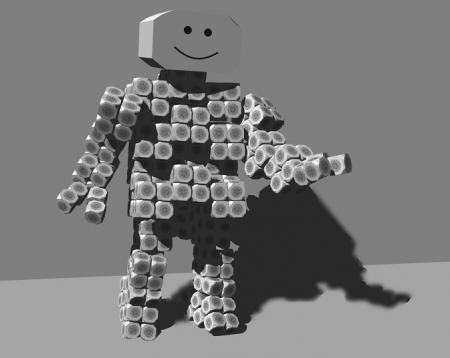BY LETTER
Blockbot
Technology > Technology Type or Material > Drytech/Hylotech
Technology > Technology Levels > High Tech / Hitech
Technology > Application > Robotics
Technology > Technology Levels > High Tech / Hitech
Technology > Application > Robotics
 Image from Steve Bowers |
First developed in the Information Age, blockbots are possibly the oldest modular robotic system produced by Terragen mindkind. [Incomplete records from this period make this statement difficult to prove.] When deployed during the Interplanetary Age, blockbots took the form of a set of computing and energy "blocks" of various sizes and shapes which could be snapped together in different ways to create any number of robot brain/bodies. When combined with the appropriate accessory components (motors, sensors, limbs, etc.) simple robots could be made to perform a limited number of tasks and then remade to perform other tasks. In the early years of space travel this was often preferable to transporting a large, complex, multifunctional robot that would be over designed for most jobs or a large number of specialized robots that would be under used for most jobs. Even when not in use in robots early spacers and colonists could use the blocks to build such things as privacy walls and extra storage boxes or use the computing and energy blocks as plug-ins to upgrade other computing and energy systems.
In the following centuries blockbots would be kept relevant through the continuous addition of new accessory components to their toolbox and the general advance of technology. In the current era blockbots continue to be used and are now a whole class of modular robotic systems with different series, or sets, favoured by different clades. Although some series have been designed by transapients, or use their technology, modosophont sets are more common and a good example of high tech blockbot design comes from Clade Stevens.
The Stevens' series uses a simple, 1 cm, truncated cube as a base sub-unit. Packed with MOTEs, it is a powerful computing resource. Set flush into each octagonal face is a motorized connector while the triangular faces each have a port for a plug-in sensor. These connectors are capable of extending, retracting, rotating, tilting and even sliding across their face in recessed tracks so there is already a fair bit of articulation built into the design even without the accessory components. Furthermore, these connectors are capable of accepting slightly smaller connectors on sub-units of reduced sizes, allowing for progressively smaller sub-units (even down to the mesoscale) to be added. Clade Stevens has even created nanoscale accessory components for their blockbot series: One can fashion a crude but functional bushbot out of these sub-units. It is also possible to combine the base sub-units into larger blocks and, if reenforced with a suitable frame, bots larger than a hu can be assembled.
Although the individual blockbot sub-units can be scaled down to the size of a foglet it has to be noted that a foglet is a complete robot while the "botblocks" are not.
Related Articles
Appears in Topics
Development Notes
Text by M. Alan Kazlev and AI Vin
Initially published on 03 December 2001.
Revised by AI Vin October 2010
Initially published on 03 December 2001.
Revised by AI Vin October 2010






